literature | 19.10.2007
Germany's Historic Anna Amalia Library Reopens After Fire
The restoration of Germany's Dutchess Anna Amalia Library in Weimar has been completed three years after it was damaged by fire. The library, a UNESCO World Heritage site, reopens to the public on Wednesday, Oct. 24.
The 2004 blaze destroyed 37 paintings and 50,000 books, all of them hundreds of years old. It also revived Germany's trauma over the loss of irreplaceable archives and libraries to bombs during World War II.
The fire was caused by an electrical malfunction.
When the library reopens Wednesday, it will have 60,000 of its original volumes, said director Michael Knoche. Thousands more are still being repaired. Restoration work is expected to continue until 2015.
Goethe's literary treasures
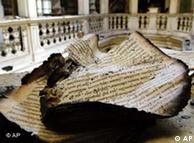 Bildunterschrift: Großansicht des Bildes mit der Bildunterschrift: Fire destroyed 50,000 historic books
Bildunterschrift: Großansicht des Bildes mit der Bildunterschrift: Fire destroyed 50,000 historic books
The restoration has cost 12.8 million euros ($18.2 million) as workers have painstakingly restored not only the books, but the building itself, including the library's famous Rococo room. The reading room is a lofty gilded gallery with busts of poets, paintings and bookcases set against white walls.
"It has always been more than just a library," said Hellmut Seemann, head of the foundation managing the library, saying visitors regarded it as a shrine to German classicism.
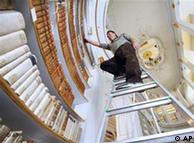 Bildunterschrift: Großansicht des Bildes mit der Bildunterschrift: An impressive collection
Bildunterschrift: Großansicht des Bildes mit der Bildunterschrift: An impressive collection
Built in 1691, the library specializes in German literature between 1750 and 1850 and houses some one million books, including many rare first-editions and the largest collection of Faust by Johann Wolfgang Goethe. Goethe, one of Germany's best-known authors, worked as a librarian at the Anna Amalia.
Weimar, a city about 250 kilometers (150 miles) southwest of Berlin in the eastern German state of Thuringia, is the region's cultural center. It also served as the backdrop for the German republic, which was declared there in 1919.
Saving history
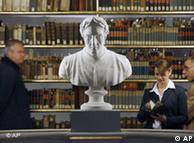 Bildunterschrift: Großansicht des Bildes mit der Bildunterschrift: German classical culture lives on in the library
Bildunterschrift: Großansicht des Bildes mit der Bildunterschrift: German classical culture lives on in the library
On the day of the fire, as flames licked at the library's roof, people formed a human chain to save as many books as possible. They salvaged some 6,000 historical works, including a 1543 Martin Luther.
Since then, some 22,000 German firms and people donated funds to repair the Anna Amalia, or to pay to repair books or buy replacements. Library staff estimates that two of every three of the lost books can be bought from other collections or in auctions.
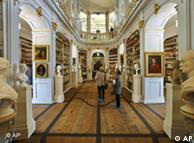 Bildunterschrift: Großansicht des Bildes mit der Bildunterschrift: A UNESCO world heritage site
Bildunterschrift: Großansicht des Bildes mit der Bildunterschrift: A UNESCO world heritage site
"It was the worst library fire in Germany since the War," said Jens Goebel, culture minister of Thuringia, at the start of a week of celebrations to mark the opening.
The official reopening will be presided over by German President Horst Köhler.
The Duchess Anna Amalia Library in Weimar, Thuringia, Germany houses a major collection of German literature and historical documents. The library contains:
- 1,000,000 books
- 2,000 medieval and early modern manuscripts
- 600 ancestral registers
- 10,000 maps
- 4,000 musical scripts
The research library today has approximately 850,000 volumes with collection emphasis on the German literature. Among its special collections is an important Shakespeare collection of approximately 10,000 volumes, as well as a 16th century Bible connected to Martin Luther.
History
The Duchess Anna Amalia Library is named for Anna Amalia, Duchess of Saxe-Weimar-Eisenach, who arranged in 1766 for the courtly (hoefische) book collection to be moved into the library.
The main building is the Green Castle (Grünes Schloss), Anna's residence, which had been built between 1562 and 1565. The dowager Duchess had the building converted into a library in 1761. The Duchess, seeking a tutor for her son Duke Carl August, hired Christoph Martin Wieland, an important poet and noted translator of William Shakespeare. Wieland's Shakespeare volumes formed the core of the collection. From an architectural standpoint, the library is world famous for its oval Rococo hall featuring a portrait of Grand Duke Carl August.
One of the library's most famous patrons was Johann Wolfgang von Goethe, who worked there from 1797 to 1832. The library also includes the world's largest Faust collection. The Duchess's significant 13,000-volume music collection is also available in the library.
In World War II, most of the collection was housed elsewhere to preserve them from Allied bombing.
Today, the library is a public research library for literature and art history. The main focus is German literature from the Classical and the late Romantic eras.
Modern extension
In 2001, construction began on a new multiple-floor facility to house some 1,000,000 books under the "Plaza of Democracy" (Platz der Demokratie) between the Music University and the Red and Yellow Castle. In its pre-renovation state, the building had structural flaws which endangered many valuable books and the special collections.
The new development is estimated to cost €24 million and has an area of 6,300 m². The area is divided into upper and lower floors. The new building would connect the historical library building with the user areas of the reconstructed Red and Yellow Castle. The grand opening of the new complex is slated for February 2005.
Fire of 2004
Part of the collection was burned in a fire on September 2, 2004, which destroyed 30,000 irreplaceable volumes, with another 20,000 severely damaged. However, some 6,000 historical works were saved, including the 1534 Lutheran Bible and a collection of Alexander von Humboldt's papers, by being passed hand-over-hand out of the building. Some other books are being freeze-dried in Leipzig to save them from rotting as a result of water damage. The fire came as a particular tragedy, in part because the collection was scheduled to move to another site in late October, a little more than a month from when the tragic fire struck. In June 2005, it was announced that manuscripts that were out of the building at the time of the fire, and thus saved, included a hitherto undiscovered 1713 aria by Johann Sebastian Bach titled "Alles mit Gott und nichts ohn' ihn".
External links
- Library Goes up in Flames, Destroying Literary Legacy
- (Jerusalem Post)
- Associated Press article
- BBC article
- MSNBC article
- New York Times article
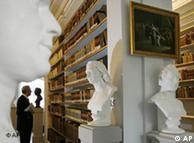





沒有留言:
張貼留言